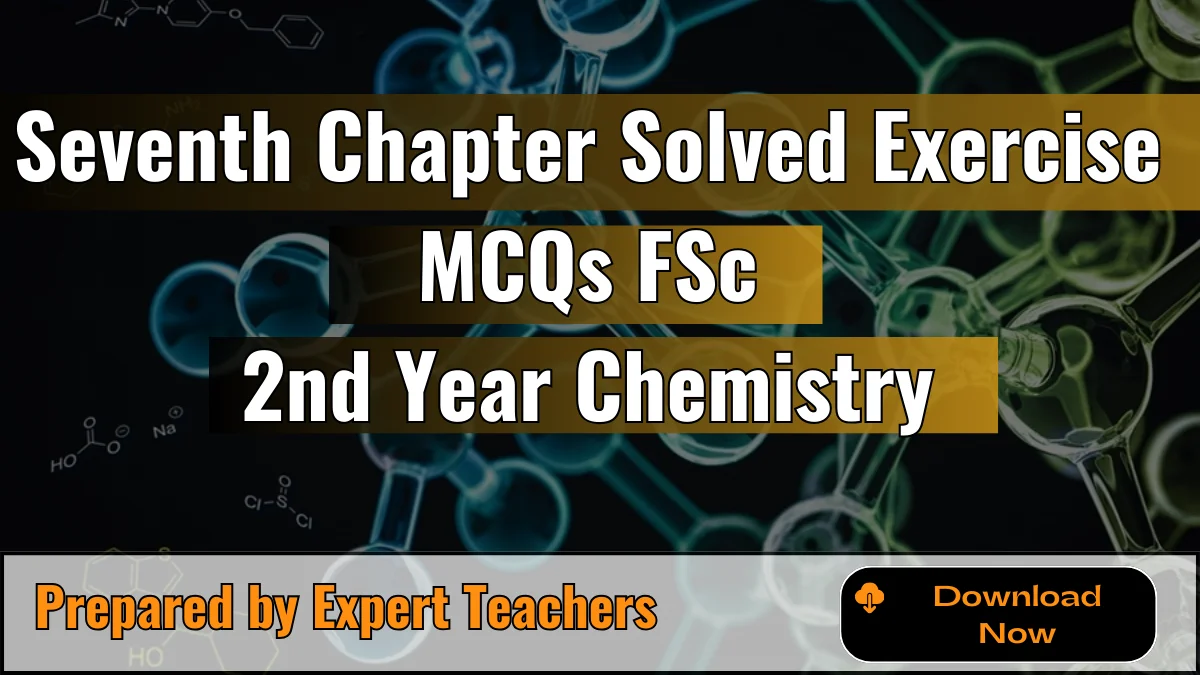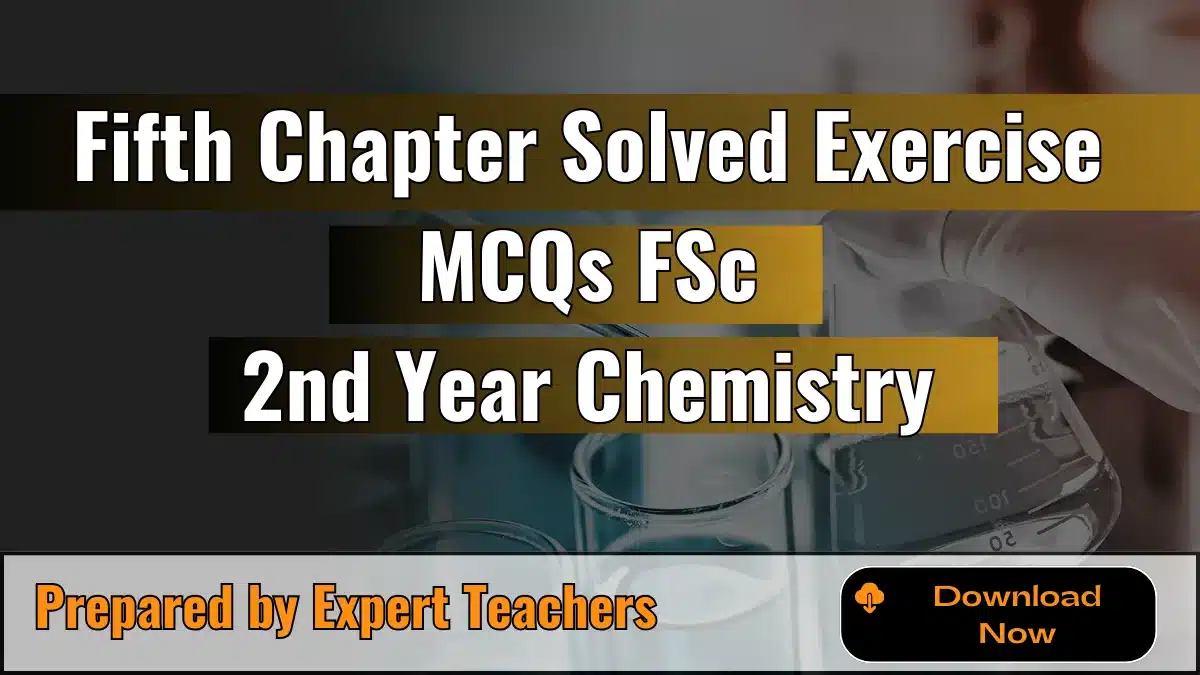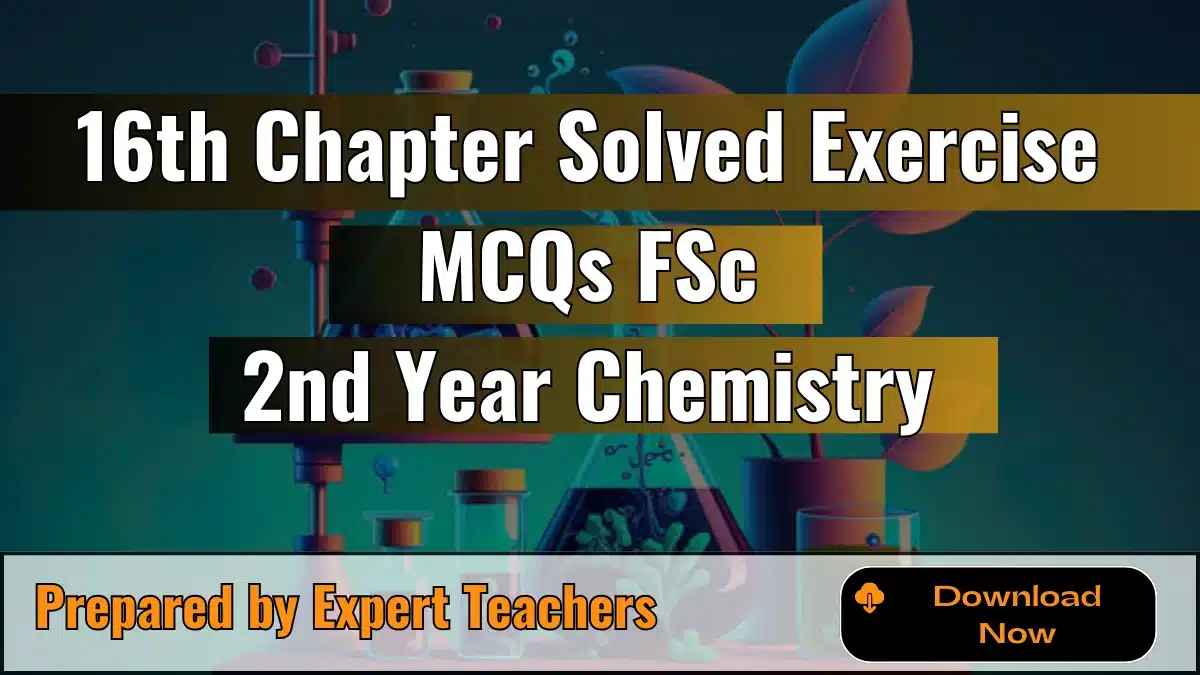Third Chapter Solved Exercise MCQs Of FSC Second Year Chemistry
The 3rd Chapter Solved Exercise MCQs of FSC 2nd-year Chemistry provides a complete set of solved multiple-choice questions (MCQs). Each MCQ comes with a brief explanation to help you understand the correct answer. These solutions are designed to support students in preparing for their exams, making complex concepts easier to grasp and ensuring a solid foundation for success.
Third chapter solved MCQs with explanation
1. Which metal is used in the thermite process because of its reactivity:
(a) Iron
(b) Copper
(c) Aluminium
(d) Zinc
Explanation: Option (c) is correct. Because Aluminium is used in the thermite process because it is highly reactive and has a strong affinity for oxygen. In the thermite reaction, aluminium reduces metal oxides (like iron oxide) to produce free metal (like iron) and aluminium oxide, releasing a large amount of heat. This heat is enough to melt the metal, making the process useful for welding and metal extraction.
2. Aluminium oxide is:
(a) acidic oxide
(b) basic oxide
(c) amphoteric oxide
(d) none of these
Explanation: Option (c) is correct. Because Aluminium oxide (Al₂O₃) can react with both acids and bases, which means it has both acidic and basic properties. This ability to behave as both an acid and a base makes it an amphoteric oxide.
For example:
• With acids: Al₂O₃ + 6HCl → 2AlCl₃ + 3H₂O
• With bases: Al₂O₃ + 2NaOH + 3H₂O → 2Na[Al(OH)₄]
3. Chemical composition of colemanite is:
(a) Ca₂B₆O₁₁•5H₂O
(b) CaB₄O₇•4H₂O
(c) Na₂B₄O₇•4H₂O
(d) CaNaB₅O₉•8H₂O
Explanation: Option (a) is correct. Because Colemanite is a borate mineral that contains calcium, boron, oxygen, and water. Its chemical formula is typically represented as Ca₂B₆O₁₁•5H₂O, indicating it has calcium, six boron atoms, and five water molecules of hydration. The other options do not match the structure of colemanite.
4. Which element forms an ion with charge +3:
(a) Beryllium
(b) Aluminium
(c) Carbon
(d) Silicon
Explanation: Option (b) is correct. Because Aluminium (Al) has an atomic number of 13, meaning it has 3 electrons in its outermost shell (3 valence electrons). To achieve a stable electron configuration (like the noble gas neon), it loses these 3 electrons, forming an ion with a charge of +3 (Al³⁺). Beryllium forms a +2 ion, while carbon and silicon generally form covalent bonds instead of forming ions with a +3 charge.
5. Which electronic configuration corresponds to an element of Group IIIA of the periodic table:
(a) 1s², 2s², 2p⁶, 3s², 3p¹
(b) 1s², 2s², 2p⁶, 3s², 3p⁶, 4s²
(c) 1s², 2s², 2p⁶
(d) 1s², 2s², 2p⁶, 3s², 3p³
Explanation: Option (a) is correct. Because Group IIIA (Group 13) elements have three valence electrons. The electronic configuration of an element in Group IIIA ends with ns² np¹, where “n” is the principal quantum number (energy level). Option (a) ends with 3s² 3p¹, indicating it has 3 valence electrons, which corresponds to a Group IIIA element (like Aluminum). Other options either have too few or too many electrons to match a Group IIIA element.
6. Which element belongs to Group IVA of the periodic table?
(a) Barium
(b) Iodine
(c) Lead
(d) Oxygen
Explanation: Option (c) is correct. Because Group IVA (or Group 14) of the periodic table includes elements that have four electrons in their outer shell. Lead (Pb) is in this group. The other elements listed belong to different groups:
• Barium (Ba) is in Group IIA (Group 2).
• Iodine (I) is in Group VIIA (Group 17).
• Oxygen (O) is in Group VIA (Group 16).
7. Which of the following elements is not present abundantly in earth’s crust?
(a) Silicon
(b) Aluminium
(c) Sodium
(d) Oxygen
Explanation: Option (a) is correct. Because the Earth’s crust is mainly composed of silicon and oxygen, which form silicate minerals. Aluminum is also present in significant amounts. Sodium, while present, is not as abundant as silicon, oxygen, and aluminum in the Earth’s crust.
8. Tincal is a mineral of:
(a) Al
(b) B
(c) Si
(d) C
Explanation: Option (b) is correct. Because Tincal, also known as borax, is a mineral that primarily contains boron (B). It is used in various industrial applications and as a component in certain cleaning products.
9. Which of the following is the chemical formula of cryolite?
(a) Na₃AlF₆
(b) Al₂O₃•2H₂O
(c) Al₂O₃
(d) Al₂O₃•H₂O
Explanation: Option (a) is correct. Because cryolite is a mineral composed of sodium, aluminum, and fluorine, with the chemical formula Na₃AlF₆.







Leave a Reply